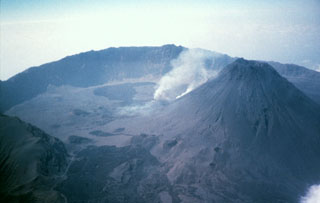Report on Fogo (Cabo Verde) — 19 November-25 November 2014
Smithsonian Institution / US Geological Survey
Weekly Volcanic Activity Report, 19 November-25 November 2014
Managing Editor: Sally Sennert.
Please cite this report as:
Global Volcanism Program, 2014. Report on Fogo (Cabo Verde) (Sennert, S, ed.). Weekly Volcanic Activity Report, 19 November-25 November 2014. Smithsonian Institution and US Geological Survey.
Fogo
Cabo Verde
14.95°N, 24.35°W; summit elev. 2829 m
All times are local (unless otherwise noted)
According to news articles an eruption from Fogo's Pico cone inside the Cha Caldera began in the morning on 23 November after increased activity detected in the previous weeks and felt earthquakes by residents the night before. The eruption started at a vent on the WSW base of Pico cone, near or at where explosions originated in 1995, and then rose from multiple vents. The activity was characterized by explosions, lava fountains, and ash emissions. About 700 people evacuated from Chã das Caldeiras and the local airport closed. During the afternoon on 24 November workers removed items from the national park headquarters and by the evening lava had overtaken the building. Lava flows had crossed a main road and taken down communication poles. The Toulouse VAAC noted that a cloud observed in satellite images composed mainly of sulfur dioxide drifted over 220 km NW at an altitude of 9.1 km (30,000 ft) a.s.l. Ash in the cloud was detected at lower altitudes. By 25 November the lava flow was 4 km long.
Geological Summary. The island of Fogo consists of a single massive stratovolcano that is the most prominent of the Cape Verde Islands. The roughly circular 25-km-wide island is truncated by a large 9-km-wide caldera that is breached to the east and has a headwall 1 km high. The caldera is located asymmetrically NE of the center of the island and was formed as a result of massive lateral collapse of the older Monte Armarelo edifice. A very youthful steep-sided central cone, Pico, rises more than 1 km above the caldera floor to about 100 m above the rim. Pico, which is capped by a 500-m-wide, 150-m-deep summit crater, was apparently in almost continuous activity from the time of Portuguese settlement in 1500 CE until around 1760. Later lava flows, some from vents on the caldera floor, reached the eastern coast below the breached caldera.
Sources: Darwin Volcanic Ash Advisory Centre (VAAC), BBC News, Boston

